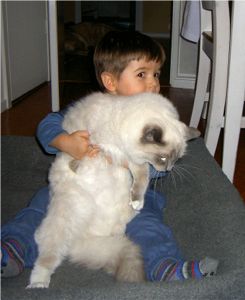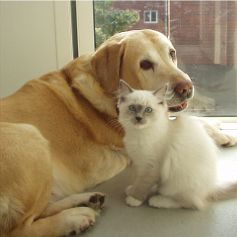

The history of the ragdollcat
The first ragdollbreeder was Mrs Ann Baker in California. Her neighbour
had a white persian Angora, Josephine, and Mrs Ann Baker was eager to
have this female cat mated with a sacred birma, to be able to keep the
offspring. This offspring together with a burmese outcrossing was the
foundation of the breed.
But Mrs Ann Baker started to spread weird rumours about her cats, for
example that they couldn´t feel any pain, which is not true at all!
That´s why ragdollbreeders broke with Mrs Ann Baker.
Another famous ragdollbreeder, Mr Denny Dayton, started to develope the
breed, and in the year of 1969 he maneged to have the breed accepted and
legitimated by Cat Fanciers standards. The first ragdoll, "Suchfun
Misty Knight", was imported to Sweden in 1991.

S*Krickelins Noblesse & David
The temperament of ragdoll
At first you must know that every ragdoll is an individual and it has its own personality. Which means that not all ragdolls have the same temper, but a ragdoll usually is a very calm and tolerant cat, especially at home. These qualities and their tendency to go limp when they are hold is probably reasons for why they are so popular. The fact that the ragdoll is so relaxed make them splendid as a familycat, but you must make your children understand that a ragdoll is not a toy! The ragdoll is also very social and they love to have company. Therefore you should have two ragdolls if you work a lot. They are also marvelous companions to other pets.

S*Eurovisions My Star & Billy
A free short description of the ragdollstandard
The ragdoll is a massive, large cat with a medium to strong boned muscular
body. There are three different varieties, colourpoint, mitted and bicolour
(agouti or non-agouti) - and 20 colourvareties - altogether 60 varieties
The head is medium sized with a broad modified wedge. Slightly rounded
forehead (not domed) showing a gentle transition to a flat plane between
the ears. Good height in profile.There should be a slight curve in the
upper third of the straight nose.
The chin and the nose as well as the cheeks must be well devoloped. The
ears are medium and wide set and tilt slightly forward. The eyes are big,
oval and blue, the darker the better.
The body must be long and wide over the shoulders as well as in the hind
quarters. The legs are medium size with big paws. The tail must be long
(preferably to the shoulders) and well furnished.
The coat of the ragdoll is long but not as long as the coat of persians.
The coat is soft, dense and feels like cold silk to touch. So the coat
is ratherrabbitlike and does not tend to mat, therefore these cats don´t
need excessive grooming.
The ragdoll is a pointed cat, so they have contrasts of colour between
different parts of their body. The tail, face, ears, and legs are darker
than the rest of the body. All three varieties are pointed, but the colourpointed
cat is not allowed to have any white markings in difference of the mitted
and bicolourvarieties.
The mitted cat have points as the colourpoint, but not at the paws and
chin. This variety can have a white stripe on the nose. Finally the mitted
cat should have a white stripe going from the bib, over the stomach, up
to the base of the tail. Faults for the mittedvariety is lack of whie
chin, any dark spot on the white mittens, any dark spot on the belly and
lack of the white stripe.
About the bicolour variety, the lower part of the body is white while
the upper part maintains the colourpoint pattern. On a bicolourcat the
cat´s face has a large V-shaped patch. This variety is unique for
the ragdoll since the 03-patterns is little more specific for ragdolls
compared for other breeds. For exemple faults for ragdollbicolourpattern
is white on ears ans white on the tail.